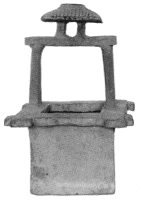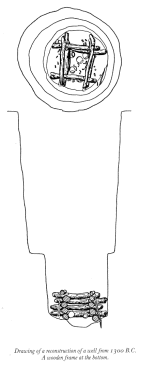Hexagram
47 and 48
You
are the tree
Your
mind is like a tree, its roots reaching deep down inside into the spring of
life, the waters of inspiration and love and wonder. Its branches reach into the
world, offering shelter and shadow and finding light and air.
If this tree reaches all the way from the deep waters to the high
heavens, it is a real tree of life.
Hex.47: Let the branches move freely on the winds, supple and without any
frustration. The tree needs the water of hex.48 so it can grow and live.
Likewise all your actions and contacts in the world need your own inspiration.
If you just follow habits or customs your tree will wither.
Hex.48: let the roots go deeper than deep, where they will find the primeval
waters. The picture of the hexagram name resembles the magic square, one of the
mandala’s representing cosmic order. Many peoples have this image in varying
forms. The waters from the well are connected with cosmic values, they bring up
myth. Therefore their working is inspiring, they encompass much more than
thought can imagine.

 |
Lindqvist
about the well:
A
well with a roof and fence, it says in Shuowen, published in 121, because that
is what wells looked like at the time, and this can also occasionally be seen in
the Han period grave sculptures.
It is the
well curb, says Bernhard Karlgren and other scholars, yet archaeological
finds made in the twentieth century do not support that theory. They
reveal unambiguously that ancient wells were round. The best-preserved one
stems from the Zhou period, and it was even lined with half-meter-high
rings of pottery. For a long time, no well was found that had a form which
could explain the appearance of the character.
But in 1985, results
were published of excavations begun outside the town of Gaocheng a decade
earlier. Among many remarkable finds were two wells, the earliest found in
China to date. They are carbon-14 dated to about 1300 B.C. and so are
contemporary with the oracle bones.
In
my opinion, their construction may explain the character for well. Like
all other wells already found, the wells in Gaocheng are round, but –
and this is what is exciting – right at the bottom lies a square frame
made of logs placed in four or five layers on top of each other. Together,
their shape agrees entirely with that of the character for well.
Cecilia Lindqvist, "China, empire of living symbols". 1989,
ISBN 0-201-57009-2, Addison-Wesley Publishing Company, Inc. |
But why this wooden frame?
Consider
what it is like to dig a hole in a sandy shore. At first the sand is dry and
fine, but the deeper one digs, the wetter the sand. In Falsterbo in southern
Sweden, where I spent childhood summers, we used to build sandcastles on the
shore and surround them with moats and walls. But the problem was always that
the deeper we dug, the more water seeped in
from below.
Eventually the moats swiftly silted up again and the castle collapsed.
Early
Chinese well diggers struggled with a similar problem when digging in the soft
loess soil. When they at last got so deep that the subsoil water started
trickling through, the walls began to be undermined. To counteract this, a frame
of logs was placed at the bottom of the well so that the water could continue to
surge in without doing major damage.
Once above
the groundwater level, the problem was over. Still water does not make the soil
collapse. The nearer the surface – the eye of the well – the wider and more
open the well could be. The wells in Gaocheng were formed in this way – as can
be seen clearly from the reconstruction drawings.
The
image of the logs in the depths of the well was one that everyone saw. Fetching
water was part of the endless, inescapable daily labor. Leaning against the edge
of the well, each person must wait for the vessel to fill slowly with water.
Insects scuttle about, breaking the surface of the water, and down in the very
depths a square of wood can be seen. A brief moment of quiet, then the surface
clears again, and it is time to heave on the rope and haul up the vessel.
One of the wells is nearly three meters in diameter and five meters deep.
At the bottom was found not only the wooden frame but also the remains of about
twenty clay vessels that had once been dropped by people fetching water from the
well. There were also some small bone articles such as spoons and hairpins,
easily dropped when leaning too far over the edge.
On some of the bronze characters for well there is a dot in the middle. What
does that mean? Long before the Gaocheng wells were found, some Chinese scholars
maintained that it was the bucket that brings the water up from the well.
Considering the new finds, that explanation seems convincing.
But if one
draws a frame around the character for well, it looks very much like several of
the ancient characters for field.
Does
the character show a field with the well strategically placed in the middle?
Some scholars have put forward that idea, referring to the old scripts.
°
In the works of the philosopher Mencius (g74 – 28g) there is a description of
a system for dividing up land used at the beginning of the Zhou period. Every
piece of land was carefully measured and divided into nine different sections.
It was looked after by eight families, each of whom had the right to cultivate
one field for their own needs, and together they looked after the middle field
on behalf of the ruler, as a kind of tax. When the population increased, new
land was cultivated and divided in the same way.
This way
of dividing up land is usually called the well-field system because of the
similarity to the character for well.
It
is mentioned in songs and poems as early as 8oo B.C., but whether it really
existed and functioned as Mencius describes it is one of the most-discussed
questions in Chinese history. Was it simply an ideal, or was it a real system
for the division of land?
It has
been said that, to Mencius, it was probably a utopian dream of a just society in
which everyone had his living secured. Then he tried to convince his
contemporaries that the utopia had once been reality and could be so again.
In Xu
Guangqi’s seventeenth-century book on agricultural techniques, the system is
presented like this: eight men, in the middle the ruler’s public field.
When
Mencius described the system in the fourth century B.C., land was already
beginning to pass into private hands. Iron plows and improved use of ma-nure
brought with them an increase in the productiv-ity of agriculture, so it was
important for the rulers to try to reduce the ‘private’ land and increase
the ‘public.’ Increased resources could, for instance, be used to build
irrigation installations and roads, which would further increase the ruler’s
power and the opportunity to control the country and perhaps expand it.

